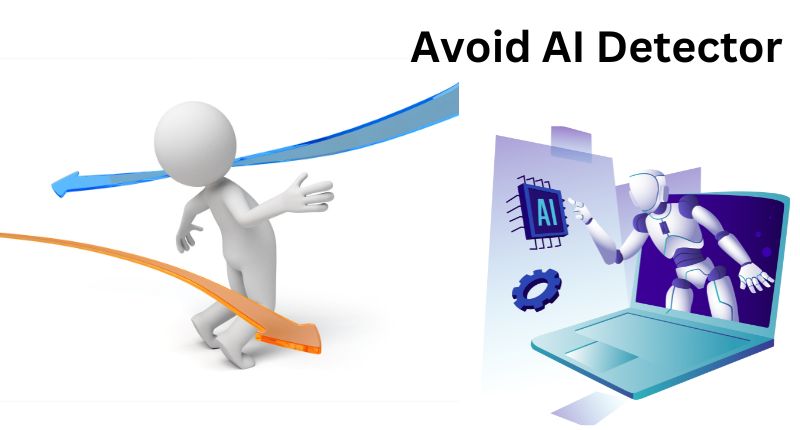How to avoid AI detector? In the contemporary digital landscape, the pervasive influence of AI content detectors has reshaped the way individuals engage with and produce content. Navigating these sophisticated systems has become a necessity for content creators and everyday internet users alike. This comprehensive guide aims to unravel the intricacies of avoiding AI detection while maintaining ethical standards and legal compliance.
As we traverse the digital realm, AI content detectors silently scrutinize the content we create and consume. This guide serves as a beacon for those seeking to understand and maneuver through the intricate landscape of AI detection. We’ll explore not only the technical aspects but also the ethical considerations that come with attempting to bypass these detectors.
Table of Contents
Understanding AI Content Detectors
The Evolution of AI Detection Technology
AI content detectors have evolved significantly, moving beyond simple keyword matching to employing advanced technologies like natural language processing (NLP) and machine learning. This section delves into the technological underpinnings of these detectors, offering readers a comprehensive understanding of their functioning.
Applications Across Industries
From social media platforms to educational institutions, AI content detectors have found applications across diverse industries. An exploration of these various use cases sheds light on the omnipresence of AI detection in our digital lives.
Why Bypass AI Content Detectors?
While the motivations for bypassing AI content detectors may vary—from maintaining privacy to pushing creative boundaries—it’s essential to explore the broader implications. This section provides an in-depth examination of the reasons individuals seek to avoid detection and the potential consequences they might face.
How AI Content Detectors Work
Understanding the mechanics behind AI content detectors is fundamental to devising effective strategies for bypassing them. These systems leverage advanced algorithms and technologies to scrutinize digital content. Let’s unravel the intricacies of their functioning:
Advanced Algorithms and Pattern Recognition
At the core of AI content detectors lies the prowess of sophisticated algorithms. These algorithms are designed to sift through vast amounts of data, learning to discern patterns and anomalies. Through machine learning models, these detectors become adept at recognizing specific features, from keywords to semantic structures.
Key Components of AI Detection Algorithms:
- Natural Language Processing (NLP): NLP enables detectors to comprehend and analyze human language, identifying nuances and context within textual content.
- Machine Learning Models: These models, often trained on extensive datasets, empower detectors to predict and classify content based on learned patterns.
Example: Consider a social media platform using AI content detection to identify hate speech. The algorithm, trained on diverse examples of hate speech, learns to recognize linguistic patterns indicative of harmful content.
Popular AI Content Detection Tools
To gain practical insights, it’s essential to familiarize ourselves with some prevalent AI content detection tools. These tools employ diverse approaches, ranging from rule-based systems to deep learning techniques:
- Content Moderator API by Microsoft Azure:
- Leverages machine learning to assess and filter potentially offensive content.
- Utilizes image and text analysis for a comprehensive content moderation solution.
- Google Cloud Vision API:
- Employs image analysis to identify and categorize content within images.
- Utilizes OCR (Optical Character Recognition) for text extraction from images.
- Jigsaw’s Perspective API:
- Focuses on evaluating the “toxicity” of text, identifying potentially harmful language.
- Trains on vast datasets to understand context and provide nuanced results.
Comparative Analysis:
| Tool | Key Features | Applications |
|---|---|---|
| Content Moderator API | – Text and image analysis | – Social media platforms |
| Google Cloud Vision API | – Image analysis with OCR | – Image-based content moderation |
| Jigsaw’s Perspective API | – Toxicity detection in text | – Online comment sections and forums |
The Role of Neural Networks
Many modern AI content detectors deploy neural networks, specifically deep neural networks, for intricate analysis. These networks consist of layers of interconnected nodes, mimicking the human brain’s structure. In the context of content detection, these networks excel at identifying complex patterns and relationships within data.
Deep Learning in Content Detection:
- Convolutional Neural Networks (CNNs): Ideal for image-based content detection, CNNs excel at recognizing visual patterns, making them valuable in applications like filtering explicit images.
- Recurrent Neural Networks (RNNs): Particularly effective in processing sequential data, RNNs enhance the analysis of textual content by considering the contextual flow of words.
Note: Understanding the specific neural network architecture employed by a content detector is crucial for crafting strategies to bypass its detection capabilities.
Legal Ramifications
Attempting to bypass AI content detectors is not without its legal pitfalls. This section outlines the potential consequences individuals may face, emphasizing the importance of staying within legal boundaries.
Ethical Dilemmas
Beyond legal concerns, the ethical considerations of circumventing AI content detectors are paramount. Striking a balance between creativity and responsible behavior is explored, encouraging readers to think critically about their actions.
Strategies: How to Avoid AI Detector
Effectively bypassing AI content detectors requires a strategic approach that encompasses various techniques. Content creators and individuals looking to avoid detection often employ a combination of methods. Let’s delve into some key strategies:
1. Cloaking Techniques
a. Substitution Cloaking
One method involves substituting certain words or phrases with synonyms, creating content that conveys a similar message while evading keyword triggers. This strategy challenges detectors relying heavily on specific terms.
Example: Original: The controversial topic sparked intense debates. Cloaked: The contentious subject ignited heated discussions.
b. IP Cloaking
Masking the source IP address of content can confuse detectors, making it appear as if the content is originating from a different location. This technique adds an extra layer of complexity for detection algorithms.
Implementation: Utilizing virtual private networks (VPNs) or proxy servers to alter the IP address associated with content submissions.
2. Encryption Methods
a. End-to-End Encryption
Encrypting content from end to end ensures that only authorized parties can decipher and understand its meaning. This method is particularly effective for protecting sensitive information from detection.
Implementation: Using encryption tools or protocols such as HTTPS to secure the transmission of content across platforms.
b. Obfuscation
Obfuscating content involves intentionally complicating its structure, making it challenging for detectors to interpret. This strategy introduces randomness into the content, disrupting pattern recognition.
Technique: Adding redundant elements, changing sentence structures, or including irrelevant information to obscure the true nature of the content.
3. Dynamic Content Creation
a. Natural Language Variations
Crafting content with variations in language, sentence structures, and word choices helps elude detection algorithms that are programmed to identify specific patterns.
Approach: Avoiding standardized templates and introducing unique elements in each piece of content to reduce predictability.
b. Image-Based Content
Shifting focus from text to images poses a challenge to text-based content detectors. By incorporating vital information into images, content creators can sidestep algorithms designed to analyze text.
Implementation: Embedding textual content within images or relying on visual elements to convey messages.
Case Studies
To understand the practical application of these strategies, let’s explore a couple of case studies:
Case Study 1: Substitution Cloaking in Social Media
An individual, seeking to discuss sensitive topics on social media without triggering content filters, strategically employs substitution cloaking. By substituting potentially flagged words with synonyms, the user successfully shares content that navigates detection algorithms.
Case Study 2: End-to-End Encryption in Communication
In a scenario where private communication is paramount, individuals use end-to-end encryption tools for messaging. By securing the content from sender to recipient, they ensure that the message remains confidential and avoids detection.
Balancing Act: Ethical Considerations
While these strategies offer ways to bypass AI content detectors, it’s crucial to emphasize the importance of ethical considerations. Responsible content creation involves striking a balance between freedom of expression and adherence to platform guidelines.
Promoting Ethical Content Creation
Encouraging content creators to embrace ethical alternatives fosters an environment where creativity flourishes without compromising integrity. This involves being mindful of the potential impact of content on users and society at large.
In navigating the complex landscape of AI content detection, content creators must weigh the benefits of avoiding detection against the ethical responsibilities associated with their digital presence. The strategies outlined here provide a starting point for those seeking to maintain a delicate equilibrium between creative expression and responsible content creation.
Case Studies
Successful Content Bypass Strategies
Examining real-world instances where individuals successfully navigated AI content detectors provides tangible insights into effective strategies.
Analyzing Failures
Understanding the reasons behind failed attempts to bypass detection is equally important. Learning from mistakes helps refine future strategies.
VIII. Balancing Act: Ethical Considerations
Responsible AI Use
Exploring ethical alternatives to bypassing AI content detectors, emphasizing the importance of responsible AI use in content creation.
Promoting Ethical Content Creation
Encouraging a shift towards ethical content creation practices, fostering an environment where creators can thrive without compromising integrity.
Future Trends in AI Content Detection
Emerging Technologies
Anticipating the future of AI content detection by exploring emerging technologies and their potential impact on content creation.
Preparing for Advancements
Providing insights into how content creators can proactively prepare for advancements in AI detection, ensuring they remain ahead of the curve.
Practical Tips for Content Creators
– Language and Formatting Tricks
Sentence Structure Variation
Exploring the importance of varying sentence structures to avoid predictability in content, a key strategy in bypassing detection.
Font and Style Variation
Discussing the subtle nuances of font and style changes as a means of circumventing detection algorithms.
– Stay Updated
AI Content Detection Tools Comparison Table
A detailed comparison table of popular AI content detection tools, helping content creators stay informed about the latest advancements.
Ethical Content Creation Checklist
Providing a checklist for content creators to ensure their work aligns with ethical standards while remaining engaging and creative.
Conclusion: How to Avoid AI Detector
In wrapping up this extensive guide, it’s crucial to reiterate the key points covered. Understanding, respecting, and navigating AI content detectors require a multi-faceted approach. By acknowledging risks, exploring responsible alternatives, and staying informed, content creators can thrive in the AI-dominated landscape.
Additional Resources and References
If you’re curious about the intricacies of how AI detectors operate, explore our detailed exploration in “How Do AI Detectors Work.” Understanding the underlying algorithms and technologies is crucial for those seeking to navigate the world of AI content detection effectively. Read more.
For those looking to unleash innovation in the digital age through AI, delve into “AI Business Ideas: Unleashing Innovation in the Digital Age.” This resource provides insights into creative business applications of artificial intelligence, opening doors to new possibilities. Discover more.
FAQs: How to Avoid AI Detector
How to bypass AI Content Detector?
Bypassing AI content detectors necessitates a strategic approach, including techniques like cloaking, encryption, and dynamic content creation. However, it’s crucial to consider the ethical implications and potential risks associated with these methods.
How do I avoid AI detection?
Avoiding AI detection involves staying informed about detection methods and proactively adjusting content creation strategies. Dynamic content, language variations, and responsible use of encryption are practical tips.
How are students getting around AI detectors?
Students may employ similar techniques as content creators, such as cloaking and dynamic content creation. However, it’s essential to highlight the importance of academic integrity and the potential consequences of attempting to bypass educational AI detectors.
How do I make AI undetectable?
Making AI undetectable is a complex task. Encryption, cloaking, and staying abreast of AI advancements are crucial. However, it’s essential to approach this with responsibility, considering the legal and ethical implications.
By incorporating these strategies and being aware of the risks, individuals can navigate the AI content detection landscape effectively, ensuring their creative endeavors flourish.


